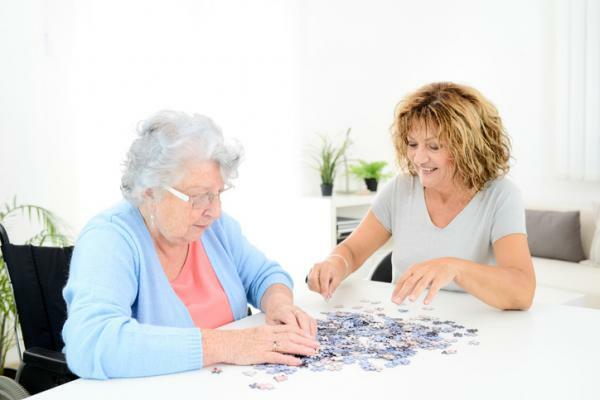
Dementia consists of the deterioration of the intellectual functions of the person who suffers from it. We commonly associate dementia with memory problems, although we must bear in mind that the functions that are impaired or are deteriorating can be diverse: comprehension or production of language, attentional and perceptual processes, executive functions such as planning, etc.
Sometimes people with dementia can find themselves agitated and / or upset. Logically, our way of acting and interacting to calm you is not the same as we would use to communicate with people without cognitive impairment. Therefore, in this online psychology article we give you some advice on how to calm a person with senile dementia through 10 guidelines.
Keep in mind that all of them will not be applicable to all cases in the same way, since we must always take into account the degree of deterioration of the person with dementia.
Index
- Assess the causes of the disturbance
- Stand at the same height to speak to him
- Use a tone of voice that conveys calm
- Avoid scolding him
- Listen actively
- Use short and simple sentences to communicate
- Avoid infantilizing him
- Uses non-verbal language and values physical contact
- Help solve the problem
- Redirect their attention
Assess the causes of the disturbance.
It is possible that the alteration may be being caused by some stimulus that we can get rid of: a noise, a draft, a light, etc. If this is so, by common sense and as far as possible, we must end this stimulus or, if it is not possible, taking the person to another room may be a good solution.
In the event that we do not know how to identify the reason, we must initiate, as far as possible, possible due to the deterioration, a communication with the person with dementia to explore the cause of their discomfort. To do this, you can follow the guidelines set out in the following sections.
Finally, it is possible that there are certain stimuli that tend to alter the person. If it has happened before, of course try to avoid, as far as possible, that you encounter such stimuli.
Stand at the same height to speak to him.
To initiate a communication, we must be at the same height as the person with whom we are going to communicate. If you are in a wheelchair, we should sit down we also to be at the same height, which will favor the communication process.
In the following article, you will find more information about How a person with senile dementia behaves, symptoms and phases.

Use a tone of voice that conveys calm.
Using a tone of voice as calm as possible will transmit calm to the person with whom we want to communicate. If you wonder how to calm a person with dementia, you should know that behavior by imitation it can make the person with whom we are interacting tend to adopt our state of mind.
In this sense, we must self-observe and be attentive to our own emotional state, since, in the same way, we can tend to alter ourselves before their attitude.
Avoid scolding him.
It is possible that when faced with alterations such as physical and / or verbal aggressions, we tend to “scold” the person by seeing and / or clearly supposing that the problem was started by him or her. In these cases, we tend to use phrases such as “you are passing” or “look at what you are messing about”. These actions can negatively affect the condition of the person with dementia.
You should always keep in mind that you are facing a person with cognitive limitations and that maybe, because of her alteration, she doesn't reason the way you want her to.
Listen actively.
Contrary to the previous section, show your interest in what happened and how the person experienced it. Being empathetic and becoming allies to solve the problem will give the sick person security regarding our figure.
We must not only listen, but we must also make feelingsr that the other person feels heard. Do not finish his sentences, even if it is difficult for him to communicate, be patient and let him freely express his emotions and feelings (as long as it does not harm himself and / or third parties).
Use short and simple sentences to communicate.
We must always keep in mind the degree of deterioration of the person with whom we are communicating. It is possible that the capacity of comprehension (and also the production capacity) is already depleted enough to be a limitation when it comes to communicating.
As dementia progresses we must use clearer, shorter, simpler sentences and more specific questions: "I understand that you are like this" or "Would you like to come to the patio?"
Avoid infantilizing him.
Infantilizing older people is a very common practice that can be especially counterproductive during a behavioral disturbance. We must address him or her in an affectionate and close way but avoiding a childish tone.
In addition, we must bear in mind that we are communicating with an adult and as such we must treat him, respecting his decisions (as long as they do not harm others or himself).
In this article, you will find more information about How to treat a person with senile dementia.
Use non-verbal language and value physical contact.
As we have already indicated, communication can be difficult in advanced stages of dementia. However, we can support our verbal message with non-verbal language.
In the same way, in the face of communication problems, we can assess use physical contact to reassure the person with dementia. We must value the approach always respecting the limits that the person wants to put. If he prefers that we not touch him, we must respect his decision and avoid contact.
Help solve the problem.
We must become allies of the people who suffer these alterations. To do this, we can guide, direct or assist in the troubleshooting process.
If, for example, the problem is that you want to go out for a walk but it is raining, we can try to explain that if sale will get wet and you may catch a cold and offer you an alternative solution: "If you feel like walking, we can do it around the Hall".
In more severe cases, as we have already mentioned, the person will be more limited both in communicating what is happening to them and in solving their problem. The more advanced the deterioration, the more presence we must have in the problem-solving process.

Redirect their attention.
If the person is unable to communicate, we may try to redirect your attention to some task that can offer you satisfaction or with the one that manages to relax. We can even ask you to help us carry out a simple task and offer you this task (such as sorting socks, etc.) in this way, in addition to feeling useful, you can get distracted and calm down. If you want to know how to entertain a person with senile dementia, we recommend the following article with 22 Activities for people with Alzheimer's.
This article is merely informative, in Psychology-Online we do not have the power to make a diagnosis or recommend a treatment. We invite you to go to a psychologist to treat your particular case.
If you want to read more articles similar to How to calm a person with senile dementia, we recommend that you enter our category of Neuropsychology.
Bibliography
American Psychiatric Association (2020). APA Dictionary of Psychology. Recovered from https://dictionary.apa.org
- Junqué, C. and Jurado, M.A. (2009) Aging, dementias and other degenerative processes. In Junqué, C. and Barroso, J. Neuropsychology Manual. Madrid: Synthesis.
- Jurado, M.A., Mataró, M. and Pueyo, R. (2013) Neuropsychology of diseases.


